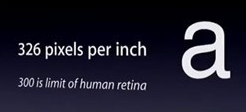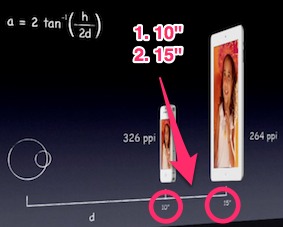With the advent of the new iPad, which has a retina display, I started thinking about what exactly a retina display is. I know it has higher resolution, but what exactly is the definition of a retina display?
5 Answers
Retina displays
To user Philip Schiller's own words from the WWDC2012:
...which means: The pixels of this display are so small that from a normal working distance your retina cannot discern those individual pixels. (watch at youtube)
There is no industry standard for "retina display". The term retina display is relative, as the definition follows the human eyes's perception of a display's sharpness.
When the iPhone 4 was introduced, Steve Jobs made the following definition:
At a distance of 10" to the human eye (or retina), a pixel density of 300PPI is the maximum that an eye can distinguish.
Because this definition is relative, calling a display a retina display depends on two factors:
- pixel density
- distance between the human eye an the display
Both the iPhone 4S and the new iPad have "retina displays" when you apply Steve Job's definition. A mathematical explanation can be found in this answer.


Retina display is a marketing term invented by Apple; it means whatever they say it means. They have said in the keynote address for the iPhone 4 that it is a display in which, when viewed by an average person at an average viewing distance, individual pixels can not be discerned.
While talking about the new display, Steve Jobs went on to detail that after a certain point the human eye fails to distinguish individual pixels. According to the Apple CEO this "magic number," when visible pixelation is no more, is around 300ppi. Therefore, with the iPhone 4's screen coming in at more than 300 pixels per inch (326ppi) the display will supposedly always looks smooth and crisp, with no jaggies in sight.
ᔥ Chris Brandrick: iPhone 4's Retina Display Explained
The iPad (3rd generation) Retina display has a lower pixel density, but it is presumed that the average viewing distance is greater.
-
-
2+1 for
it means whatever they say it means. Apple's marketing machine doing it's work again..– manojldsCommented Mar 21, 2012 at 1:16
The definition according to Wikipedia:
The screen is marketed by Apple as the "Retina Display", based on the assertion that a display of approximately 300 ppi at a distance of 12 inches (305 mm) from one's eye, or 57 arcseconds per pixel is the maximum amount of detail that the human retina can perceive.
-
-
1How many levels of nested citations would you like me to provide?– AJ.Commented Mar 20, 2012 at 19:16
-
3When the only thing you pull from a source is a quote from another source, it is proper to cite the original source—particularly when Wikipedia did the right thing and provided you with a direct link to that source.– jabergCommented Mar 20, 2012 at 19:28
A retina display is one that equals or surpasses the human eye in resolution - in other words where the resolution of the display is higher than the visual acuity of the eye. Specifically the fovia centralis which is the central region of the retina with the highest visual acuity, or sharpness.
The fovia centralis in the typical human eye can discern two lines as separate when they are more that 57 arcseconds apart, taking the eye as the center of the angle. That's 0.16 degrees apart. For instance, hold your hand at arms length and examine the hairs. You'll find that hairs that are very close together will appear to be one hair, but as you bring your hand closer you'll notice there are two or more hair where previously you thought there was only one.
Apple has determined (or decided...) that people hold their phones about 10" (25.4cm) from their eyes. At that distance the portion of the eye with highest visual acuity (fovia centralis) cannot discern two pixels that are 3 thousandths of an inch apart as separate pixels. The ipad is held about 15" away from your eyes, and at that distance your eye cannot discern two pixels that are 4 thousandths of an inch apart as separate pixels.
Therefore, at the ideal viewing distance, the resolution of these "retina" devices equals or exceeds the visual acuity of the portion of the human eye with the highest visual acuity - meaning that at those distances one cannot tell two adjacent pixels apart, and it appears to be one seamless image composed of continuous tones as one sees in nature, rather than a digital device composed of discrete lights.
This does mean that at a certain distance your monitor pixels will exceed your eye's visual acuity. The distinction is that there's a typical or ideal viewing distance for each display device, be it a monitor, TV, theater, or billboard. If, at that distance, the device exceeds the visual acuity of the fovia centralis, then it could be termed a retina display in the way apple is using the term. A simple trademark search for retina and retina display suggests that Apple has not trademarked this term, and none of their advertising copy has trademark near the term, so others may be able to use this term to describe their products in other ways.
-
That's interesting. Apple's definition of retina is for a maximum angle of 0.19° (3.3*10^-3 rad). So it's actually a bit too large. What's the source of your answer?– gentmattCommented Mar 20, 2012 at 20:21
-
@gentmatt I'm referring to Apple's earlier assertion: "While talking about the new display, Steve Jobs went on to detail that after a certain point the human eye fails to distinguish individual pixels. According to the Apple CEO this "magic number," when visible pixelation is no more, is around 300ppi." which was originally at 12 inches. Do the math (300dpi over 12 inches involving an arctan) and you get about 57 arcseconds, or 0.16 degrees. Recent comments suggest they are going bigger, and I suspect they are getting ready for a bigger iPhone 5 display, which may require 0.19 degrees... Commented Mar 20, 2012 at 20:35
-
That's just great if apple gives an unspecific definition and later changes it. So they used to say that 12" is the normal distance to use the iPhone (2007) but now it's 10" (keynote march 2012). Maybe they did this to cheat a bit about calling the iPad's display a retina display? I'll have to look into that.– gentmattCommented Mar 20, 2012 at 20:43
-
3@gentmatt It's all marketing anyway. There are some metrics for how closely packed the cones are in the fovia centralis (they are optimally hexagonally packed) but everyone's eyes are slightly different in terms of size, lens, etc, so there's no universally accepted visual acuity for the human eye - just a rather large range. Personally I'm just glad that someone is pushing for this. We've already exceeded our ears ability to hear (44.1kHz at 16 bits is pretty much it, although exceptional listeners need 96kHz at 24 bits), so doing this for displays is something I've wanted for a long time. Commented Mar 20, 2012 at 20:57
It has to do with normal viewing distance. The new MacBook Pro has a lower dpi than the iPad, which has a lower dpi than the iPhone, but you will normally view them from respectively farther distances. At that distance it should be impossible to discern individual pixels. I wonder how many HDTVs technically count as "retina displays" if you consider the normal viewing distance to be from across the room.
But note that if you stick even the iPhone right in your face you can glimpse individual pixels.
